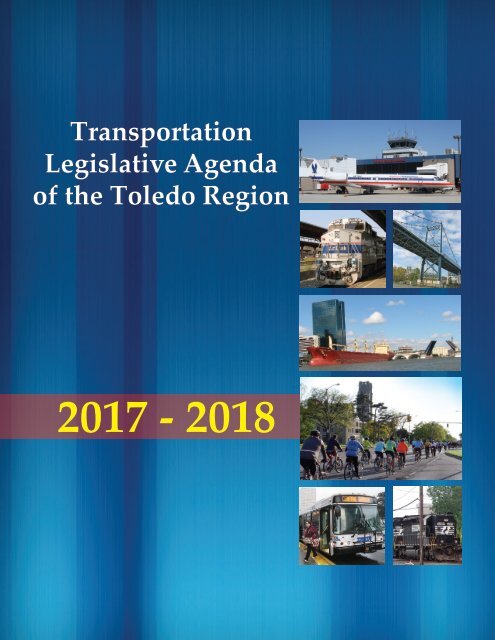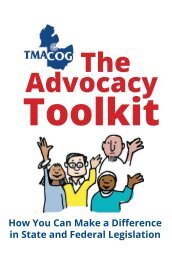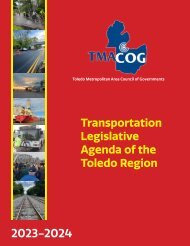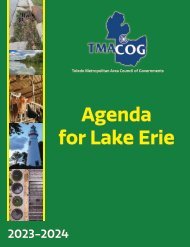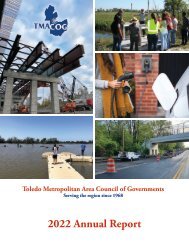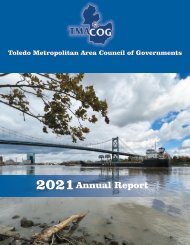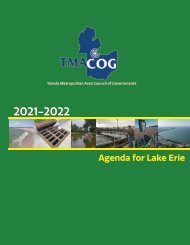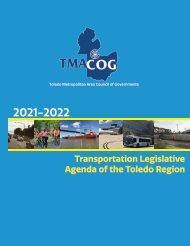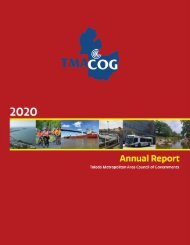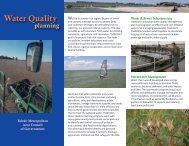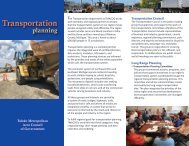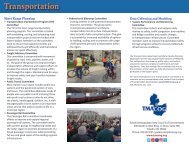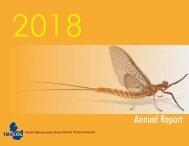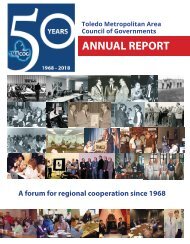Transportation Legislative Agenda of the Toledo Region 2017-2018
TMACOG Transportation Legislative Agenda of the Toledo Region 2017-2018
TMACOG Transportation Legislative Agenda of the Toledo Region 2017-2018
You also want an ePaper? Increase the reach of your titles
YUMPU automatically turns print PDFs into web optimized ePapers that Google loves.
<strong>Transportation</strong><br />
<strong>Legislative</strong> <strong>Agenda</strong><br />
<strong>of</strong> <strong>the</strong> <strong>Toledo</strong> <strong>Region</strong><br />
<strong>2017</strong> - <strong>2018</strong>
<strong>Toledo</strong> Metropolitan Area Council<br />
<strong>of</strong> Governments Board <strong>of</strong> Trustees<br />
Chair: Craig A. Stough – Mayor, City <strong>of</strong> Sylvania<br />
Vice Chair: Doris I. Herringshaw – President <strong>of</strong> Commissioners, Wood County<br />
<strong>Transportation</strong> Coalition<br />
• • •<br />
OHIO DEPARTMENT OF TRANSPORTATION<br />
Kirk Slusher – Acting Director, District 2<br />
LUCAS COUNTY<br />
Tina Skeldon Wozniak, President <strong>of</strong> Commissioners<br />
Keith G. Earley – County Engineer<br />
MONROE COUNTY<br />
J. Henry Lievens – Chairman <strong>of</strong> Commissioners, District 9<br />
OTTAWA COUNTY<br />
James M. Sass – Commissioner<br />
WOOD COUNTY<br />
Doris I. Herringshaw – President <strong>of</strong> Commissioners<br />
John Musteric – County Engineer<br />
CITY OF TOLEDO<br />
Paula S. Hicks-Hudson – Mayor<br />
TOLEDO AREA REGIONAL TRANSIT AUTHORITY (TARTA)<br />
James K. Gee – General Manager<br />
SUBURBAN MOBILITY FOR REGIONAL TRANSPORTATION (SMART)<br />
Royce R. Maniko – Board Member<br />
BOWLING GREEN (B.G.) TRANSIT<br />
Tina Bradley – Grants Administrator<br />
TOLEDO-LUCAS COUNTY PORT AUTHORITY<br />
Joseph W. Cappel – Vice President <strong>of</strong> Business Development<br />
CITY CAUCUS<br />
Mike Aspacher – President <strong>of</strong> Council, Third Ward, City <strong>of</strong> Bowling Green<br />
James M. Bagdonas – Municipal Administrator, City <strong>of</strong> Waterville<br />
David Kissinger – Council Member, City <strong>of</strong> Maumee<br />
VILLAGE CAUCUS<br />
Gordon A. Bowman – Mayor, Village <strong>of</strong> Pemberville<br />
Jordan Daugherty – Administrator, Village <strong>of</strong> Whitehouse<br />
Steven L. Fought – Mayor, Village <strong>of</strong> Gibsonburg<br />
Joseph W. Helle – Mayor, Village <strong>of</strong> Oak Harbor<br />
Jeffery C. Rae – Mayor, Village <strong>of</strong> Berkey<br />
TOWNSHIP CAUCUS<br />
Andrew J. Bick – Trustee, Township <strong>of</strong> Richfield<br />
Penelope S. Getz – Trustee, Township <strong>of</strong> Middleton<br />
Michael Hampton – Administrator, Township <strong>of</strong> Springfield<br />
E. Mark Hummer – Administrator & Police Chief, Township <strong>of</strong> Lake<br />
Donald O. Sahl<strong>of</strong>f – Trustee, Township <strong>of</strong> Whiteford<br />
SCHOOL DISTRICT CAUCUS<br />
Ronald W. Matter – Superintendent, Penta Career Center<br />
Meghan Schmidbauer – Assistant Dean, Owens Community College<br />
SPECIAL DISTRICTS AND AUTHORITIES CAUCUS<br />
Cheryl Johnson – Chair, Wood County Port Authority<br />
Neil A. Munger – Director, Wood County Park District<br />
NON-GOVERNMENTAL MEMBERS<br />
Margaret K. Adams – Area Manager, FirstEnergy/<strong>Toledo</strong> Edison<br />
Steve Bergman – Vice President, The Mannik & Smith Group, Inc.<br />
Brad Fisher – Board President, Eastern Maumee Bay Chamber <strong>of</strong> Commerce<br />
Edward A. Hoeffel – Vice President, Maumee Valley Heritage Corridor, Inc.<br />
Michael Jay – Director <strong>of</strong> Strategic Networks, <strong>Region</strong>al Growth Partnership<br />
Thomas G. Mackin – General Counsel, Lucas Metropolitan Housing Authority<br />
Dennis W. McMickens – President and CEO, Safety Council <strong>of</strong> Northwest Ohio<br />
David W. Nunn – Attorney, Eastman & Smith, Ltd.<br />
Gary R. Samples – Black Swamp Conservancy<br />
Laura Saunders-Kowalec – VP/Government Banking Relationship Manager, Huntington Bank<br />
Scott A. Strahley – RCAP Engineer, WSOS CAC, Inc.<br />
Joel Schlageter – Commercial Lending, First Federal Bank<br />
Stephen M. Way, P.E. – Principal, Managing Director, DGL Consulting Engineers, LLC<br />
2-10-17
<strong>Transportation</strong> <strong>Legislative</strong> <strong>Agenda</strong> <strong>of</strong> <strong>the</strong> <strong>Toledo</strong> <strong>Region</strong><br />
Federal <strong>Transportation</strong> Funding Brief<br />
Prudent investments are needed now to prevent fur<strong>the</strong>r deterioration <strong>of</strong> our streets, highways, bridges, rail and<br />
transit systems, pedestrian and bikeway systems, airports, ports, and waterways. The public sector has a<br />
responsibility to act to improve safety, support quality <strong>of</strong> life, increase employment opportunities, and enhance<br />
economic competitiveness. The strategies and recommendations included in <strong>the</strong> <strong>Toledo</strong> <strong>Region</strong> <strong>Transportation</strong><br />
<strong>Legislative</strong> <strong>Agenda</strong> are <strong>the</strong> consensus view <strong>of</strong> <strong>the</strong> members <strong>of</strong> <strong>the</strong> <strong>Transportation</strong> Coalition. Consultative meetings<br />
held with coalition members between October 2016 and February <strong>2017</strong> produced a set <strong>of</strong> legislative policy<br />
recommendations and modal policy briefs for federal, state, and local leaders. The <strong>Toledo</strong> Metropolitan Area<br />
Council <strong>of</strong> Governments presents this agenda on behalf <strong>of</strong> <strong>the</strong> northwest Ohio region.<br />
FEDERAL Priorities<br />
<strong>2017</strong>-<strong>2018</strong><br />
Online Policy Hub: www. tmacog.org/TMACOG_Trans_<strong>Legislative</strong>_<strong>Agenda</strong>/<br />
<br />
<br />
<br />
<br />
<br />
<br />
<br />
<br />
<br />
<br />
<br />
Ensure <strong>the</strong> long-term solvency <strong>of</strong> <strong>the</strong> Highway Trust Fund and support <strong>the</strong> ability <strong>of</strong> state and local<br />
governments to plan, fund, and construct <strong>the</strong> projects that will rebuild our infrastructure and streng<strong>the</strong>n our<br />
economy. The longer repairs are postponed, <strong>the</strong> more <strong>the</strong>y cost.<br />
Prefer user taxes and fees such as <strong>the</strong> motor fuel tax and o<strong>the</strong>r fuels taxes (aviation, etc.), a vehicle miles<br />
traveled (VMT) fee, freight waybill tax, shipping container fees, impact fees, tolling, and similar strategies.<br />
Design <strong>the</strong>se fees with attention to <strong>the</strong> fee per unit, <strong>the</strong> means to adjust <strong>the</strong> fee over time (such as linking to<br />
Consumer Price Index), administrative costs, and privacy safeguards.<br />
Where appropriate, attract private capital via public-private partnerships that feature transparent<br />
agreements and accountability through tightly monitored performance standards.<br />
Support changes to federal tax law to enable private individuals and corporations to contribute to<br />
construction and maintenance <strong>of</strong> public infrastructure on a tax-deductible basis. Retain <strong>the</strong> tax-exempt<br />
status <strong>of</strong> municipal bonds (i.e., governmental bonds and private activity bonds) in order to support lower<br />
borrowing costs for locally developed infrastructure projects.<br />
Leverage public funds and encourage private co-investment via credit assistance programs such as<br />
infrastructure banks, <strong>the</strong> <strong>Transportation</strong> Infrastructure Finance and Innovation Act (TIFIA), <strong>the</strong> Railroad<br />
Rehabilitation & Improvement Financing (RRIF) program, etc. Improve and broaden <strong>the</strong> feasibility <strong>of</strong> <strong>the</strong>se<br />
and o<strong>the</strong>r innovative financing mechanisms by streamlining application timelines and requirements.<br />
Support funding for intelligent transportation systems to improve <strong>the</strong> safety and efficiency <strong>of</strong> transport.<br />
Implement a national strategic freight plan and improve flexibility to expend funds on airport, port, rail,<br />
intermodal, and o<strong>the</strong>r key freight investments. Implement <strong>the</strong> 2016 Water Infrastructure Improvements for<br />
<strong>the</strong> Nation Act (WIIN). Maintain a regular, biannual process <strong>of</strong> authorizing projects and activities related to<br />
<strong>the</strong> key missions <strong>of</strong> <strong>the</strong> U.S. Army Corps <strong>of</strong> Engineers.<br />
Support Harbor Maintenance Tax (HMT) revenue solutions and use HMT funds for intended purposes.<br />
Provide an exemption from <strong>the</strong> HMT for domestic and U.S.—Canadian movements for non-bulk cargo<br />
within <strong>the</strong> Great Lakes and St. Lawrence Seaway System.<br />
Equitably fund all modes <strong>of</strong> transportation including increasing <strong>the</strong> share allocated to public transportation<br />
(Mass Transit Account), passenger rail, and active transportation (<strong>the</strong> <strong>Transportation</strong> Alternatives Program).<br />
Appropriate passenger rail funding as authorized in <strong>the</strong> FAST Act.<br />
Continue subsidizing transportation out <strong>of</strong> general treasury funds until a permanent solution to <strong>the</strong><br />
infrastructure funding gap is implemented.<br />
2-10-17
State and Local <strong>Transportation</strong> Funding Policy Brief<br />
Prudent investments are needed now to prevent fur<strong>the</strong>r deterioration <strong>of</strong> our streets, highways, bridges, rail and<br />
transit systems, pedestrian and bikeway systems, airports, ports, and waterways. The public sector has a<br />
responsibility to act to improve safety, support quality <strong>of</strong> life, increase employment opportunities, and enhance<br />
economic competitiveness. The strategies and recommendations included <strong>the</strong> <strong>Toledo</strong> <strong>Region</strong> <strong>Transportation</strong><br />
<strong>Legislative</strong> <strong>Agenda</strong> are <strong>the</strong> consensus view <strong>of</strong> <strong>the</strong> members <strong>of</strong> <strong>the</strong> <strong>Transportation</strong> Coalition. Consultative meetings<br />
held with coalition members between October 2016 and February <strong>2017</strong> produced a set <strong>of</strong> legislative policy<br />
recommendations and modal policy briefs for federal, state, and local leaders. The <strong>Toledo</strong> Metropolitan Area<br />
Council <strong>of</strong> Governments presents this agenda on behalf <strong>of</strong> <strong>the</strong> northwest Ohio region.<br />
STATE Priorities<br />
<br />
<br />
<br />
<br />
<br />
<br />
<br />
<br />
<br />
In <strong>the</strong> absence <strong>of</strong> improved federal funding, Ohio must take state level action to deliver locally identified projects by<br />
increasing existing revenue sources and developing new sources. Equitably fund all modes <strong>of</strong> transportation<br />
including increasing <strong>the</strong> share allocated to public transportation, railways, ports, airports, and active transportation.<br />
To prevent fur<strong>the</strong>r erosion in purchasing power <strong>of</strong> <strong>the</strong> revenue from Ohio’s flat rate per gallon motor fuel excise tax,<br />
consider indexing some or all <strong>of</strong> <strong>the</strong> tax. Among <strong>the</strong> options for indexing are <strong>the</strong> Consumer Price Index, <strong>the</strong> average<br />
wholesale price <strong>of</strong> fuel, <strong>the</strong> Producer Price Index, and o<strong>the</strong>rs.<br />
Due to increasing vehicle fuel efficiency and <strong>the</strong> growing use <strong>of</strong> alternative fuels, Ohio should consider implementing<br />
a vehicle miles traveled user fee to counteract declining revenue from traditional sources.<br />
Regarding <strong>the</strong> Ohio Turnpike, keep toll rate increases to a minimum. Use toll-generated revenue primarily to<br />
preserve and expand <strong>the</strong> turnpike itself. Distributions <strong>of</strong> bonds backed by toll revenue should stay within<br />
jurisdictions closest in geographic proximity to <strong>the</strong> turnpike, should produce a net gain in transportation dollars for<br />
those jurisdictions, and should be limited to infrastructure projects with a lifespan commensurate with <strong>the</strong> term <strong>of</strong><br />
funding instrument.<br />
Support <strong>the</strong> recommendations contained in <strong>the</strong> 2015 ODOT Statewide Transit Needs Study, including: increased<br />
capital funding, better regionalization <strong>of</strong> transit systems, and <strong>the</strong> establishment <strong>of</strong> a bi-partisan state legislative<br />
commission to develop ways to create a reliable, dedicated, and sufficient funding stream to increase public transit<br />
services in Ohio.<br />
Implement <strong>the</strong> recommendations <strong>of</strong> ODOT’s Ohio Airports Focus Study.<br />
Continue programs such as <strong>the</strong> Ohio Bridge Partnership Program, <strong>the</strong> Clean Ohio Fund, <strong>the</strong> State Capital<br />
Improvements Program, and Local <strong>Transportation</strong> Improvements Program.<br />
Assist municipalities with full funding for resurfacing and reconstruction on U.S. and state routes within <strong>the</strong>ir<br />
jurisdiction such as by expanding ODOT’s Urban Paving Program.<br />
Allow localities to impose local option taxes, such as by supporting an increase in Ohio’s base vehicle license plate fee<br />
and allowing counties and municipalities to enact permissive use plate fees.<br />
LOCAL Priorities<br />
<br />
<br />
<strong>Transportation</strong> <strong>Legislative</strong> <strong>Agenda</strong> <strong>of</strong> <strong>the</strong> <strong>Toledo</strong> <strong>Region</strong><br />
<strong>2017</strong>-<strong>2018</strong><br />
Online Policy Hub: www. tmacog.org/TMACOG_Trans_<strong>Legislative</strong>_<strong>Agenda</strong>/<br />
Explore expanding use and funding <strong>of</strong> specially designated <strong>Transportation</strong> Improvement Districts (TIDs) such as<br />
those in <strong>the</strong> city <strong>of</strong> Rossford and Lucas County.<br />
Support efforts to fund and operate a truly regional, seamless public transit system to serve all <strong>of</strong> <strong>the</strong> greater <strong>Toledo</strong><br />
metropolitan area including all <strong>of</strong> Lucas County. Provide cost effective access to surrounding counties and<br />
connections to and between major cities in <strong>the</strong> region.<br />
2-10-17
FEDERAL Priorities<br />
<br />
<br />
<br />
<br />
<strong>Transportation</strong> <strong>Legislative</strong> <strong>Agenda</strong> <strong>of</strong> <strong>the</strong> <strong>Toledo</strong> <strong>Region</strong><br />
Logistics <strong>Transportation</strong> Policy Brief<br />
Continue to implement <strong>the</strong> FAST Act freight programs such as developing a National Highway Freight program<br />
that includes funding for Nationally Significant Freight and Highway Projects. Continue funding for <strong>the</strong><br />
Fostering Advancements in Shipping and <strong>Transportation</strong> for <strong>the</strong> Long-term Achievement <strong>of</strong> National Efficiencies<br />
(FASTLANE) grants.<br />
Improve connectivity between freight modes, freight facilities, and key industrial areas where freight-intensive<br />
production is possible in <strong>the</strong> future or is occurring now.<br />
The shortage <strong>of</strong> commercial vehicle drivers is prompting a crisis in freight transportation. Support short-term<br />
relief and long-term incentives that address workforce issues across <strong>the</strong> supply chain including reasonable hours<br />
<strong>of</strong> services and o<strong>the</strong>r driver regulations.<br />
Foster a bilateral approach to U.S.—Canadian trade policy and border management that enhances <strong>the</strong> secure flow<br />
<strong>of</strong> goods and people across our shared border.<br />
In <strong>the</strong> next 10 years, national freight tonnage will grow dramatically and <strong>Toledo</strong> is <strong>the</strong> at <strong>the</strong><br />
center <strong>of</strong> this trend. The region’s strategic geography includes <strong>the</strong> intersection <strong>of</strong> I-80/90 & I-<br />
75, CSX North Baltimore National Gateway, Norfolk Sou<strong>the</strong>rn Airline Yard, and <strong>the</strong> <strong>Toledo</strong><br />
Seaport.<br />
Marine, rail, runway, and roadway assets provide access to market, workforce, and<br />
significant industrial space.<br />
Prominent sectors include agriculture, automotive, energy, food processing, and advanced<br />
manufacturing.<br />
<strong>2017</strong>-<strong>2018</strong><br />
Online Policy Hub: www. tmacog.org/TMACOG_Trans_<strong>Legislative</strong>_<strong>Agenda</strong>/<br />
STATE Priorities<br />
<br />
<br />
Review existing state laws and regulations for impediments to <strong>the</strong> safe testing and deployment <strong>of</strong> connected and<br />
automated vehicles including truck platooning and alternative fuels. Avoid creating a patchwork <strong>of</strong> inconsistent<br />
state laws by working with o<strong>the</strong>r states to standardize transport networks and support adoption <strong>of</strong> best practices.<br />
Promote design standards that remove impediments to <strong>the</strong> safe flow <strong>of</strong> freight by investing in truck-friendly<br />
intersections, ramps, turning lanes, and eliminating rail/highway conflicts. Expand commercial truck parking<br />
initiatives.<br />
LOCAL Priorities<br />
<br />
<br />
<br />
Evaluate, maintain, and upgrade pipeline infrastructure and leverage supply chain links. Leverage <strong>the</strong> region’s<br />
strategic location for trans-loading oil and gas products in a safe and efficient manner to support oil and gas<br />
production and refinement, and energy independence.<br />
Address <strong>the</strong> labor shortage in <strong>the</strong> logistics industry through development and training <strong>of</strong> CDL drivers, vehicle<br />
mechanics, and technicians with high school and community college programs.<br />
Support <strong>the</strong> initiatives <strong>of</strong> <strong>the</strong> northwest Ohio / sou<strong>the</strong>ast Michigan Comprehensive Economic Development<br />
Strategy (CEDS), a multi-county collaboration that leverages transportation assets and o<strong>the</strong>r regional competitive<br />
advantages to attract and retain jobs and investment in <strong>the</strong> region.<br />
2-10-17
FEDERAL Priorities<br />
<br />
<br />
<br />
<br />
<strong>Transportation</strong> <strong>Legislative</strong> <strong>Agenda</strong> <strong>of</strong> <strong>the</strong> <strong>Toledo</strong> <strong>Region</strong><br />
<strong>2017</strong>-<strong>2018</strong><br />
Online Policy Hub: www. tmacog.org/TMACOG_Trans_<strong>Legislative</strong>_<strong>Agenda</strong>/<br />
Air <strong>Transportation</strong> Policy Brief<br />
Support efforts to preserve and modernize <strong>the</strong> transportation assets <strong>of</strong> <strong>the</strong> Ohio Air National Guard’s 180th<br />
Fighter Wing at <strong>Toledo</strong> Express Airport (TOL). Retain <strong>the</strong> Terminal Radar Approach Control facilities<br />
(TRACON) operation at TOL as critical to maintaining <strong>the</strong> operational integrity <strong>of</strong> <strong>the</strong> 180th’s homeland<br />
security mission, which requires immediate launch <strong>of</strong> F-16 fighter jets and close coordination with <strong>the</strong> TOL<br />
air traffic control tower.<br />
Support with funding, regulatory clearances, etc., <strong>the</strong> recommendations <strong>of</strong> <strong>the</strong> Airport Master Plan for TOL<br />
as updated by <strong>the</strong> <strong>Toledo</strong>-Lucas County Port Authority.<br />
Support establishment <strong>of</strong> Priority Conservation Areas to allow mitigation <strong>of</strong> wetlands on a watershed basis<br />
ra<strong>the</strong>r than parcel-by-parcel.<br />
Promote <strong>the</strong> safe use <strong>of</strong> unmanned aircraft systems (UAS) commonly known as drones.<br />
Runway investments at air facilities throughout <strong>the</strong> region, such as <strong>the</strong> Wood County<br />
<strong>Region</strong>al Airport, are needed to retain or expand freight and passenger activity.<br />
STATE Priorities<br />
<br />
<br />
<br />
<br />
Implement <strong>the</strong> recommendations <strong>of</strong> ODOT’s Ohio Airports Focus Study.<br />
Improve connectivity <strong>of</strong> airports to surface modes. Specifically, relocate US 20A to accommodate TOL’s<br />
north/south runway extension and improve connections to I-475 via US 20A. Improve TOL’s connections to<br />
<strong>the</strong> new US 24 via SR 295.<br />
Support funding for runway and o<strong>the</strong>r improvements to increase <strong>the</strong> airside capacity <strong>of</strong> TOL when logistics<br />
operations expand beyond its current capacity.<br />
Promote consistency between federal and state regulation <strong>of</strong> unmanned aircraft systems commonly known<br />
as drones. Prohibit drone use near critical infrastructure; update circumstances that constitute trespass, and<br />
balance surveillance and privacy issues with opportunities for UAS economic development.<br />
LOCAL Priorities<br />
<br />
<br />
At <strong>Toledo</strong> Express Airport, construct ring roads and inter-terminal non-public roads (with grade separation<br />
from public streets) to allow direct triple trailer truck access to all terminals and campuses <strong>of</strong> <strong>the</strong> park.<br />
Update <strong>the</strong> control tower at <strong>Toledo</strong> Express Airport.<br />
REGIONAL Viewpoint<br />
<br />
Aviation is critical to a balanced cargo and passenger system. Success <strong>of</strong> <strong>the</strong> air transport mode depends<br />
greatly upon excellent connectivity to regional road and railways and upon preserving and expanding<br />
airport infrastructure. The airport division <strong>of</strong> <strong>the</strong> <strong>Toledo</strong>-Lucas County Port Authority operates <strong>the</strong> City <strong>of</strong><br />
<strong>Toledo</strong>’s two airports—<strong>Toledo</strong> Express Airport and <strong>Toledo</strong> Executive Airport. The airports support four<br />
major areas <strong>of</strong> aviation operations: passenger, cargo, general aviation, and military. Each operational area is<br />
important to <strong>the</strong> economic vitality <strong>of</strong> <strong>the</strong> airport and <strong>the</strong> northwest Ohio region.<br />
2-10-17
<strong>Transportation</strong> <strong>Legislative</strong> <strong>Agenda</strong> <strong>of</strong> <strong>the</strong> <strong>Toledo</strong> <strong>Region</strong><br />
<strong>2017</strong>-<strong>2018</strong><br />
Online Policy Hub: www. tmacog.org/TMACOG_Trans_<strong>Legislative</strong>_<strong>Agenda</strong>/<br />
Freight Rail Policy Brief<br />
FEDERAL Priorities<br />
Support rail-oriented public-private partnerships to leverage scarce dollars while addressing bottlenecks<br />
and moving projects forward.<br />
Create a rail infrastructure trust fund for <strong>the</strong> public portion <strong>of</strong> partnerships with private rail companies.<br />
STATE Priorities<br />
<br />
<br />
<br />
<br />
Expand and provide dedicated funding to <strong>the</strong> Ohio Rail Development Commission to rehabilitate and<br />
expand rail line capacity and short line spurs to manufacturing and industrial locations which will support<br />
job creation and retention.<br />
Support funding to preserve <strong>the</strong> right-<strong>of</strong>-way <strong>of</strong> abandoned rail lines for future uses.<br />
Leverage <strong>the</strong> nationally significant freight rail facilities in Ohio with funding for highway-rail grade<br />
separations (over/under passes) and installation <strong>of</strong> improved crossing warning devices to address safety<br />
and congestion problems.<br />
Invest in station upgrades and track improvements that support greater efficiency for both passenger and<br />
freight rail users.<br />
With 13 facilities distributed across <strong>the</strong> state, Ohio is second only to Illinois in <strong>the</strong> number<br />
<strong>of</strong> intermodal terminals.<br />
The rail network accounts for about 40% <strong>of</strong> U.S. freight movements by ton-miles (<strong>the</strong><br />
distance freight travels), and 16% by tons (<strong>the</strong> weight <strong>of</strong> freight moved).<br />
PROJECT Priorities<br />
<br />
<br />
<br />
<br />
Support rail/highway grade separation solutions resulting from blocked rail crossings such as:<br />
o Hire Road/SR 281 crossing <strong>of</strong> <strong>the</strong> CSX line in Defiance County.<br />
o Matzinger Road crossing <strong>of</strong> <strong>the</strong> CSX line in <strong>Toledo</strong>.<br />
o A North Baltimore overpass <strong>of</strong> <strong>the</strong> CSX tracks <strong>the</strong>re and SR 235/SR 18 and <strong>the</strong> CSX line in Hoytville.<br />
o Manhattan Boulevard at <strong>the</strong> CSX and Ann Arbor tracks.<br />
Improve intermodal access and development opportunity at <strong>the</strong> NS Airline Yard intermodal facility in<br />
<strong>Toledo</strong>.<br />
Complete <strong>the</strong> replacement <strong>of</strong> <strong>the</strong> Wheeling Lake Erie Maumee River Railroad Bridge.<br />
Invest in a second train bridge (to include pedestrian facilities) across <strong>the</strong> Maumee River near <strong>Toledo</strong>’s<br />
Middlegrounds to address <strong>the</strong> current choke point created by <strong>the</strong> existing swing bridge.<br />
2-10-17
FEDERAL Priorities<br />
<br />
<br />
<br />
<br />
<br />
<strong>Transportation</strong> <strong>Legislative</strong> <strong>Agenda</strong> <strong>of</strong> <strong>the</strong> <strong>Toledo</strong> <strong>Region</strong><br />
<strong>2017</strong>-<strong>2018</strong><br />
Online Policy Hub: www. tmacog.org/TMACOG_Trans_<strong>Legislative</strong>_<strong>Agenda</strong>/<br />
Marine <strong>Transportation</strong> Policy Brief<br />
Implement <strong>the</strong> 2016 Water Infrastructure Improvements for <strong>the</strong> Nation Act (WIIN). Maintain a regular,<br />
biannual process <strong>of</strong> authorizing projects and activities related to <strong>the</strong> key missions <strong>of</strong> <strong>the</strong> U.S. Army Corps <strong>of</strong><br />
Engineers.<br />
Support Harbor Maintenance Tax (HMT) revenue solutions and use HMT funds for intended purposes.<br />
Provide an exemption from <strong>the</strong> HMT for domestic and U.S.—Canadian movements for non-bulk cargo<br />
within <strong>the</strong> Great Lakes and St. Lawrence Seaway System.<br />
Support seaport-specific funding to modernize U.S. seaports including investments in technology and<br />
upgrades to locks in <strong>the</strong> St. Lawrence Seaway System. Extend <strong>the</strong> shipping season on <strong>the</strong> Great Lakes.<br />
Establish a single federal ballast water rule by adopting standards put forth by <strong>the</strong> International Maritime<br />
Organization’s Convention for <strong>the</strong> Control and Management <strong>of</strong> Ship’s Ballast Water and Sediments.<br />
Prevent Asian Carp in <strong>the</strong> Great Lakes via science-based strategies and in collaboration with shipping<br />
industry.<br />
Congress restricts spending <strong>of</strong> HMT revenue, resulting in a maintenance backlog.<br />
The <strong>Toledo</strong> harbor constitutes one quarter <strong>of</strong> total dredging in <strong>the</strong> entire Great Lakes, making<br />
it <strong>the</strong> largest annual dredging project in terms <strong>of</strong> cost and quantity dredged (800,000 to 1<br />
million cubic yards). Without dredging, <strong>the</strong> port would inevitably shut down with dire results for<br />
<strong>the</strong> regional, state, and national economies.<br />
STATE Priorities<br />
<br />
<br />
Support environmentally acceptable and financially feasible policies that enable short- and long-term<br />
management <strong>of</strong> dredged material including beneficial reuse, new capacity in existing confined disposal<br />
facilities, and/or safe disposal via policies previously identified. Continue support for <strong>the</strong> Great Lakes<br />
Dredged Material Center for Innovation.<br />
Provide reliable, long-term funding <strong>of</strong> <strong>the</strong> state’s maritime ports. Within <strong>the</strong> state biennial budget allow for<br />
tax abatements for operating terminals located within harbors recognized by <strong>the</strong> state, and <strong>of</strong>fer non-local<br />
share state grants for port infrastructure. Continue to fund multimodal initiatives.<br />
LOCAL Priorities<br />
<br />
<br />
Support efforts to develop a major north/south and east/west maritime corridor through <strong>the</strong> City <strong>of</strong> <strong>Toledo</strong>.<br />
Leverage <strong>the</strong> region’s strategic location for trans-loading oil and gas products in a safe and efficient manner<br />
to support oil and gas production and refinement, and energy independence.<br />
REGIONAL Viewpoint<br />
<br />
The <strong>Toledo</strong> Seaport is a critical economic driver, directly and indirectly supporting nearly 7,000 jobs<br />
according to a 2011 study. Direct revenue generated by firms dependent on cargo handled at <strong>the</strong> port was<br />
estimated to be over $380 million. State and federal tax revenues approached $155 million.<br />
2-10-17
FEDERAL Priorities<br />
<br />
<br />
<br />
<strong>Transportation</strong> <strong>Legislative</strong> <strong>Agenda</strong> <strong>of</strong> <strong>the</strong> <strong>Toledo</strong> <strong>Region</strong><br />
<strong>2017</strong>-<strong>2018</strong><br />
Online Policy Hub: www. tmacog.org/TMACOG_Trans_<strong>Legislative</strong>_<strong>Agenda</strong>/<br />
Passenger Rail Policy Brief<br />
Appropriate full funding for <strong>the</strong> rail programs at <strong>the</strong> amounts authorized by <strong>the</strong> FAST Act. These include<br />
programs for State <strong>of</strong> Good Repair ($140 million), Consolidated Rail Infrastructure and Safety<br />
Improvements ($190 million), and passenger rail Restoration and Enhancements grants ($20 million).<br />
Support a viable national passenger rail system through multi-year funding for Amtrak.<br />
Support expansion <strong>of</strong> passenger rail service to five daily round trips in <strong>the</strong> Chicago-<strong>Toledo</strong>-New York<br />
corridor.<br />
The Federal Rail Administration predicts dramatic growth in freight and passenger rail<br />
traffic over <strong>the</strong> next two decades.<br />
<strong>Toledo</strong> is home to <strong>the</strong> busiest Amtrak station in Ohio.<br />
Every day, <strong>the</strong> station hosts 4 Amtrak trains, 2 Amtrak busses, 24 Greyhound busses, and<br />
frequent <strong>Toledo</strong> Area <strong>Region</strong>al Transit Authority (TARTA) service.<br />
STATE Priorities<br />
<br />
<br />
<br />
<br />
<br />
<br />
Invest in station upgrades (expansions and intermodal connections) in order to improve service reliability<br />
and comply with ADA regulations.<br />
Invest in track improvements (new passing sidings, crossover tracks, etc.) in order to improve efficiency for<br />
both passenger and freight rail users.<br />
Invest in a second train bridge (to include pedestrian facilities) across <strong>the</strong> Maumee River near <strong>Toledo</strong>’s<br />
Middlegrounds to address <strong>the</strong> current choke point created by <strong>the</strong> existing swing bridge.<br />
Support <strong>the</strong> Midwest <strong>Region</strong>al Rail Initiative that includes <strong>the</strong> Lake Shore Corridor from Chicago to<br />
Pennsylvania.<br />
Advance high-speed initiatives in <strong>the</strong> Ohio Hub plan, including <strong>the</strong> Cleveland-<strong>Toledo</strong>-Detroit corridor.<br />
Support funding to preserve <strong>the</strong> right <strong>of</strong> way <strong>of</strong> abandoned rail lines for future uses.<br />
LOCAL Priorities<br />
<br />
<br />
Support economic development <strong>of</strong> <strong>the</strong> <strong>Toledo</strong>’s Amtrak train station area that includes easier on/<strong>of</strong>f access<br />
to I-75 as well as improved multi-modal (motor vehicle, transit, bicycle, and pedestrian) connections to <strong>the</strong><br />
downtown area.<br />
Support rail/highway grade separation solutions to alleviate blocked rail crossings.<br />
2-10-17
FEDERAL Priorities<br />
<br />
<strong>Transportation</strong> <strong>Legislative</strong> <strong>Agenda</strong> <strong>of</strong> <strong>the</strong> <strong>Toledo</strong> <strong>Region</strong><br />
Pedestrian and Bikeways Policy Brief<br />
Support increased funding for <strong>the</strong> <strong>Transportation</strong> Alternatives Program (TAP) that addresses bikeways,<br />
pedestrian facilities, vegetation management to improve roadway safety, historic transportation facilities,<br />
and <strong>the</strong> Safe Routes to School program.<br />
Nearly 14 % <strong>of</strong> households do not have access to a vehicle.<br />
Walking and bicycling improve environmental and personal health and can contribute<br />
to stronger local economies. Ohio currently ranks 16 th in <strong>the</strong> nation as a bicycle friendly<br />
state.<br />
<strong>2017</strong>-<strong>2018</strong><br />
Online Policy Hub: www. tmacog.org/TMACOG_Trans_<strong>Legislative</strong>_<strong>Agenda</strong>/<br />
STATE Priorities<br />
<br />
<br />
<br />
<br />
<br />
Create and implement a multi-faceted education campaign targeting law enforcement, motorists, and<br />
bicyclists to build awareness and compliance for recently passed legislation requiring that Ohio motorists<br />
pass bicyclists leaving at least three feet <strong>of</strong> clearance.<br />
Support implementation <strong>of</strong> a statewide Complete Streets Policy.<br />
Continue and increase funding for Safe Routes to School programs and projects.<br />
Support renewed funding <strong>of</strong> <strong>the</strong> Clean Ohio Fund program including <strong>the</strong> Trails Fund.<br />
Support funding to plan and construct a signed network <strong>of</strong> bicycle-friendly street routes and multi-purpose<br />
paths that enable citizens to use bicycles as a practical means <strong>of</strong> transportation.<br />
LOCAL Priorities<br />
<br />
<br />
<br />
<br />
Support implementation <strong>of</strong> <strong>the</strong> regional Complete Streets Policy and toolkit including <strong>the</strong> addition <strong>of</strong><br />
pedestrian and bicycle facilities (bike lanes or paths) with roadway construction projects. Encourage<br />
jurisdictions to adopt <strong>the</strong>ir own complete streets policies, resolutions, or ordinances.<br />
Support implementation <strong>of</strong> <strong>the</strong> regional sidewalk policy. Enforce maintenance and snow removal policies<br />
on existing facilities, and develop new facilities that address major barriers created by expressways, railroad<br />
tracks, and rivers. For example, implement <strong>the</strong> pedestrian facilities planned on <strong>the</strong> Wooster Street crossing<br />
<strong>of</strong> I-75 and <strong>the</strong> Airport Highway crossing <strong>of</strong> I-475.<br />
Approve and support local designation <strong>of</strong> <strong>the</strong> U.S. Bicycle Route System Numbered Corridors.<br />
Pursue Safe Routes to School initiatives to encourage lifelong healthy and safe personal mobility habits.<br />
REGIONAL Viewpoint<br />
<br />
A full range <strong>of</strong> mobility choices characterizes successful regions. Walking and bicycling are two methods <strong>of</strong><br />
non-motorized transportation that require infrastructure in <strong>the</strong> same way that autos require a network <strong>of</strong><br />
roads, signs, and signals. Investments in sidewalks and on- and <strong>of</strong>f-road bicycle facilities provide safe<br />
transport and support <strong>the</strong> same trip purposes as autos and transit. A safe, reliable, accessible, and<br />
multimodal network links employees to <strong>the</strong>ir places <strong>of</strong> employment and connects people <strong>of</strong> all abilities and<br />
ages to centers <strong>of</strong> commerce and to medical, educational, and recreational activities.<br />
2-10-17
<strong>Transportation</strong> <strong>Legislative</strong> <strong>Agenda</strong> <strong>of</strong> <strong>the</strong> <strong>Toledo</strong> <strong>Region</strong><br />
<strong>2017</strong>-<strong>2018</strong><br />
FEDERAL Priorities<br />
Online Policy Hub: www. tmacog.org/TMACOG_Trans_<strong>Legislative</strong>_<strong>Agenda</strong>/<br />
Public <strong>Transportation</strong> Policy Brief<br />
Retain <strong>the</strong> federal Mass Transit Account (MTA) <strong>of</strong> <strong>the</strong> Highway Trust Fund and increase its revenues.<br />
Incentivize cleaner, greener fleets and fund <strong>the</strong> replacement <strong>of</strong> existing diesel buses with environmentally<br />
sustainable, alternatively fueled vehicles.<br />
Retain <strong>the</strong> transit commuter tax benefit at <strong>the</strong> same level as <strong>the</strong> parking tax benefit.<br />
Retain <strong>the</strong> alternative fuels tax credit.<br />
Transit service requires a viable, regional solution, without which our region will be left behind.<br />
Seniors, baby boomers, and millennials increasingly seek alternatives to <strong>the</strong> automobile.<br />
Transit provides workforce connectivity. Approximately 60 % <strong>of</strong> transit trips are to and from work.<br />
STATE Priorities<br />
<br />
Support <strong>the</strong> recommendations contained in <strong>the</strong> 2015 ODOT Statewide Transit Needs Study, including: increased<br />
capital funding, better regionalization <strong>of</strong> transit systems, and <strong>the</strong> establishment <strong>of</strong> a bi-partisan state legislative<br />
commission to develop ways to create a reliable, dedicated, and sufficient funding stream to increase public<br />
transit services in Ohio.<br />
LOCAL Priorities<br />
<br />
<br />
<br />
<br />
<br />
<br />
Support implementation <strong>of</strong> locally developed Coordinated Public <strong>Transportation</strong> and Human Service<br />
<strong>Transportation</strong> plans in Lucas and Wood counties to coordinate transportation services between counties and<br />
among all providers—public, private, and non-pr<strong>of</strong>it.<br />
Eliminate <strong>the</strong> “downtown loop” in <strong>Toledo</strong> and create a multimodal transit center.<br />
Extend hours <strong>of</strong> service, streng<strong>the</strong>n regional connections, and <strong>of</strong>fer faster, more direct routes.<br />
Address <strong>the</strong> transportation needs <strong>of</strong> individuals with disabilities, older adults, and people with low incomes.<br />
Provide strategies for meeting <strong>the</strong>se needs, and prioritize transportation services for funding and<br />
implementation.<br />
Improve productivity in service delivery by implementing one-call/one-click information for users.<br />
Continue adding mechanisms to coordinate under/unserved areas in Wood County.<br />
FUNDING Priorities<br />
<br />
Support efforts to fund and operate a truly regional, seamless public transit system to serve all <strong>of</strong> <strong>the</strong> greater<br />
<strong>Toledo</strong> metropolitan area including all <strong>of</strong> Lucas County. Provide cost-effective access to surrounding counties<br />
and connections to and between major cities in <strong>the</strong> region.<br />
REGIONAL Viewpoint<br />
<br />
Successful regions are characterized by a full range <strong>of</strong> safe, reliable, accessible, and reasonably priced transit<br />
services. Mobility should be available to all Ohioans regardless <strong>of</strong> ability, age, or inclusion in any o<strong>the</strong>r federally<br />
protected class. It should be available to people regardless <strong>of</strong> <strong>the</strong>ir economic status. Transit services link<br />
employees to <strong>the</strong>ir places <strong>of</strong> employment and centers <strong>of</strong> commerce. Transit connects people to healthy food<br />
options, and to medical, educational, religious, and recreational activities.<br />
2-10-17
FEDERAL Priorities<br />
<br />
<br />
<strong>Transportation</strong> <strong>Legislative</strong> <strong>Agenda</strong> <strong>of</strong> <strong>the</strong> <strong>Toledo</strong> <strong>Region</strong><br />
<strong>2017</strong>-<strong>2018</strong><br />
Online Policy Hub: www. tmacog.org/TMACOG_Trans_<strong>Legislative</strong>_<strong>Agenda</strong>/<br />
Streets, Highways, and Bridges Policy Brief<br />
Support a sustainable approach to infrastructure funding that provides a long-term solution and addresses<br />
<strong>the</strong> growing backlog <strong>of</strong> necessary infrastructure investments. Generate additional revenue.<br />
Enable local flexibility to use federal funds according to locally identified needs. Permit municipalities to<br />
use innovative financial techniques to manage projects.<br />
Improved safety and economic opportunity are top reasons for improving our network.<br />
Invest to prevent bottlenecks and connect Ohio business to markets.<br />
STATE Priorities<br />
<br />
<br />
<br />
<br />
<br />
<br />
Support an increase in Ohio’s base vehicle license plate fee and allow counties and municipalities to enact<br />
permissive use plate fees.<br />
Continue to enable <strong>Transportation</strong> Improvement District (TID) programs as a vital tool to finance<br />
transportation projects.<br />
Assist municipalities with full funding for resurfacing and reconstruction on U.S. and state routes within<br />
<strong>the</strong>ir jurisdiction such as by expanding ODOT’s Urban Paving Program.<br />
Maintain <strong>the</strong> Jobs & Commerce division grant funding program and <strong>the</strong> Ohio Development Services<br />
Agency Roadwork Development (629) program.<br />
Continue <strong>the</strong> State Capital Improvements Program and Local <strong>Transportation</strong> Improvements Program<br />
administered by <strong>the</strong> Ohio Public Works Commission and <strong>the</strong> Ohio Bridge Partnership Program.<br />
Participate in a study <strong>of</strong> a new I-73/74/75 corridor connecting South Carolina to Michigan via Ohio.<br />
PROJECT Priorities<br />
Widen I-475/US 23 to six lanes between Central Avenue (US 20) and <strong>the</strong> Anthony Wayne Trail (US 24).<br />
Construct a new interchange at I-475 and Dorr Street.<br />
Construct a new interchange at I-475 and US 20A and upgrade US 20A between I-475 and <strong>the</strong> <strong>Toledo</strong><br />
Express Airport.<br />
Complete <strong>the</strong> reconstruction <strong>of</strong> <strong>the</strong> Anthony Wayne Trail between <strong>Toledo</strong> and Maumee and replace <strong>the</strong><br />
Norfolk Sou<strong>the</strong>rn Railroad Bridge near City Park Avenue.<br />
Reconstruct I-75 from South Avenue to Dorr Street in Downtown <strong>Toledo</strong>.<br />
Reconstruct I-75 from Glenwood Road in Wood County to South Avenue in Lucas County including <strong>the</strong> I-75<br />
DiSalle Bridge over <strong>the</strong> Maumee River and <strong>the</strong> intermodal connector ramps at South Avenue and Miami<br />
Street.<br />
Improve interchanges along <strong>the</strong> I-75 corridor including upgrading <strong>the</strong> interchange at Wooster Street (SR 64)<br />
in Bowling Green and <strong>the</strong> interchange at Cygnet Road in sou<strong>the</strong>rn Wood County.<br />
Connect Fostoria to I-75.<br />
Widen I-75 through Findlay.<br />
Replace <strong>the</strong> I-75 Brent-Spence Bridge over <strong>the</strong> Ohio River.<br />
Invest in Intelligent <strong>Transportation</strong> Systems to support connected and automated vehicles.<br />
2-10-17


